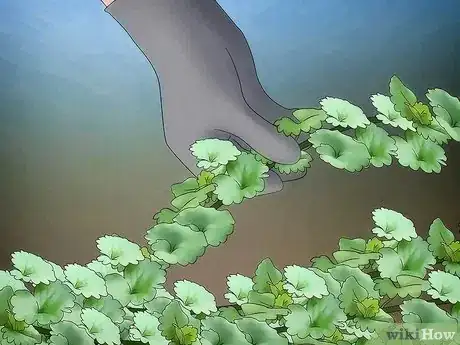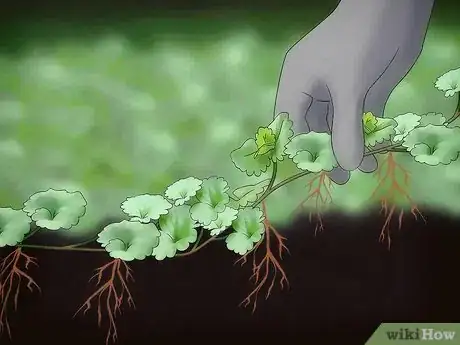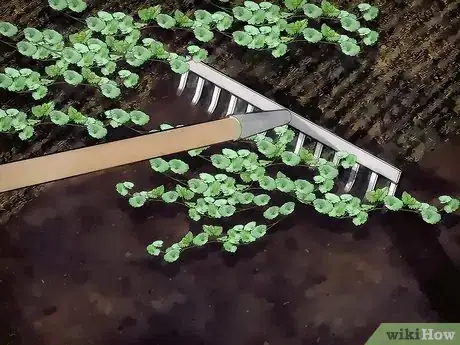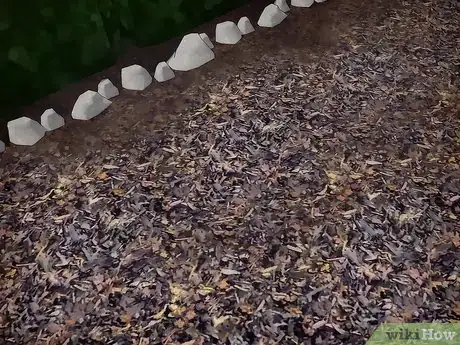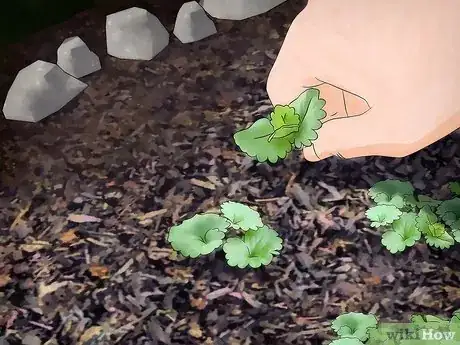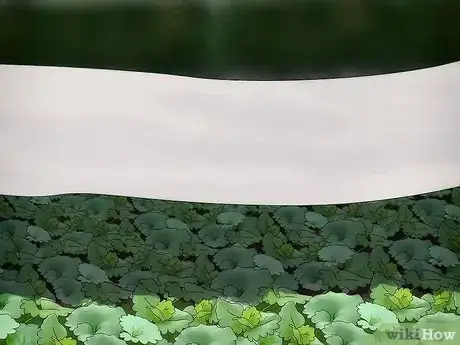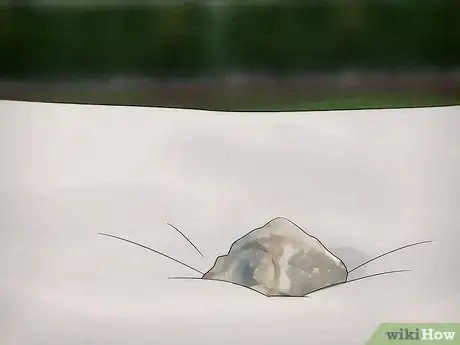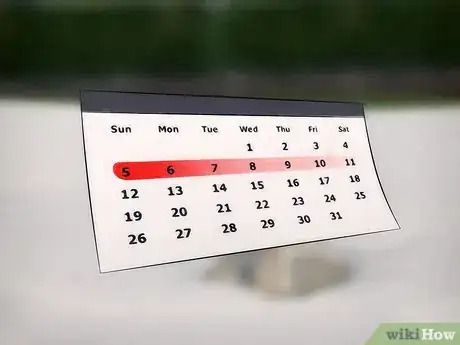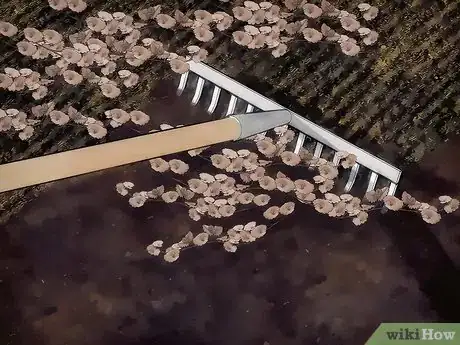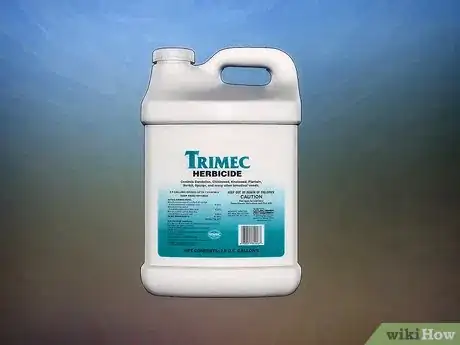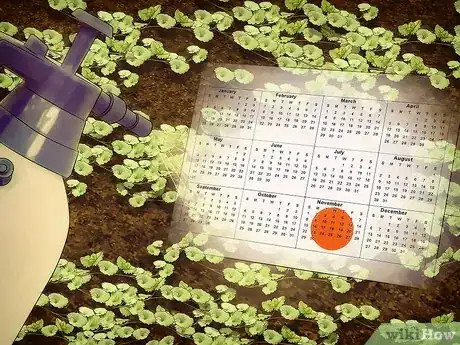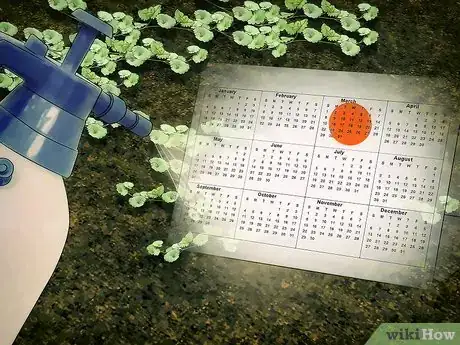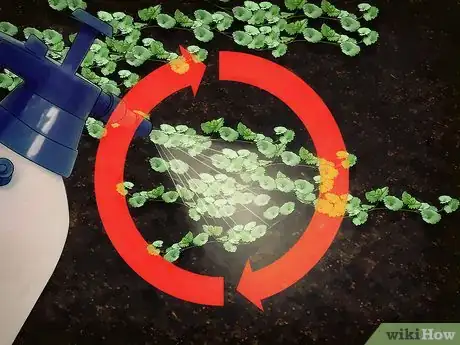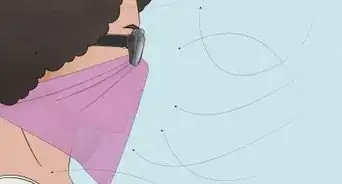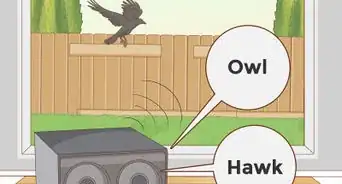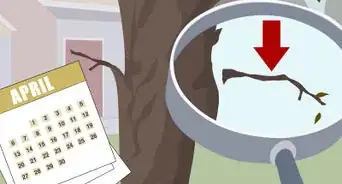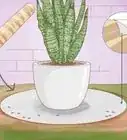This article was co-authored by Maggie Moran. Maggie Moran is a Professional Gardener in Pennsylvania.
There are 9 references cited in this article, which can be found at the bottom of the page.
wikiHow marks an article as reader-approved once it receives enough positive feedback. In this case, 87% of readers who voted found the article helpful, earning it our reader-approved status.
This article has been viewed 340,001 times.
Creeping charlie is the common name for an evergreen, creeping weed called Glechoma hederacea. It is very resilient and adaptable, which means it can quickly become a pesky, stubborn weed. The plant easily reproduces from seeds and also regrows from small cuttings, which causes rapid spreading. The vine can easily move from one lawn or area to another. It has attractive blue flowers, but it is often undesirable due to its aggressiveness.[1]
Steps
Removing Creeping Charlie Manually
-
1Identify suitable areas for manual removal. This works best in small areas covered with or affected by the plant. Areas with widespread creeping charlie will take a long time to manually remove, so you might consider sunlight deprivation or chemical treatment in these cases.
- It is recommended you wear gloves for protection if you plan to pull the plant out by hand. Gloves can prevent blisters, friction burns, and callouses from forming during manual removal.
- Creeping charlie is a common skin allergen that can cause itching or a rash from contact. Wearing gloves will prevent you from having an unexpected allergic response while weeding.[2]
-
2Remove leaves and vine growth. For plants that are especially thick, you should cut off the leaves and vines to make the roots more accessible. You can do this most easily with a few snips from a pair of pruning shears. Once the protective upper foliage is removed, you'll be able to target the roots in the ground.
- Keep bits and pieces of creeping charlie collected together off to the side or put it in a bag for disposal later. Lost bits and pieces can reseed your plot with the plant.
- You may want to avoid doing this on windy days. The wind might blow a stray leaf or vine somewhere else you don't want the plant growing.
- It is not recommended you use a hoe to break up the soil or cut through the top layer of the plant. This can spread creeping charlie even further.[3]
Advertisement -
3Pull up the roots thoroughly. In loose, loamy soil, you may find that the roots pull free with relatively little effort. However, in some cases, the roots may be very stubborn. Grasp the root by its topmost part and apply firm, steady pressure until the roots pull free.
- You may need to use a rooting tool, which is shaped like a long, flat-tipped screwdriver, to assist in removing difficult plants or those with deep-sunk roots.
- You should investigate the soil following the hand removal of roots. If you leave behind root pieces, the creeping charlie may return.[4]
-
4Dispose all clippings and roots. The leaves and vines you have cut from the plants could serve to further seed creeping charlie, so be careful when disposing this plant. Avoid places like open compost piles where the wind might carry seeds or leaves back to your plot.
- Using a thin tined rake can help you sift through dirt to find remaining creeping charlie plant debris. Even small pieces can contribute to regrowth.
- Throwing the creeping charlie away in the garbage should be sufficient, but you could also dispose of trimmings by burning them. Be sure you have a fire permit before burning, if your region requires one.[5]
-
5Add mulch to deter regrowth. After you've weeded out the creeping, you can help prevent regrowth by adding mulch, like wood chips, over the area the plant was growing. Use a regular cover of 2 - 3 in (5 - 7.6 cm) of your mulch for the best effect.[6]
-
6Remove the creeping charlie as it regrows. Getting the whole root system and removing every seed-carrying leaf can be a tall order. It's likely you'll miss a few and see the plant return. Every time you see the scalloped leaves of creeping charlie reappear, pull it out. Eventually it should stop coming back.
- You should see the creeping charlie diminish after each weeding, but it can take up to a year or longer before the plant is fully removed.[7]
Depriving Creeping Charlie of Sunlight
-
1Starve the planted of sunlight. Creeping Charlie, like other plants, needs light for growth. However, this plant can survive even in low level light, like strong shade. Because of this, if you intend to use this method, the light must be completely blocked to the plant.
-
2Cover the area affected with creeping charlie. There are many items you could use for this purpose. For example, you could lay down a large piece of cardboard, a heavy drop-cloth, or a tarp over top the plant for maximum light blockage.
- When creeping charlie is growing among plants you want to keep, you might consider cutting a circular hole around in a heavy cloth or tarp. This way you can block light to the creeping charlie around the wanted plant without denying it of light.
- Any surrounding plants that are deprived of light will die along with the creeping charlie. This likely means you'll need to reseed your plot later.[8]
-
3Protect your light cover from disturbance. Stray wind, animals, or other environmental factors can cause your light cover to shift in position. Stabilize your light cover by heaping some soil, rocks, or some other kind of weight on top of it to hold it in place.
- To ensure the light is completely blocked, you should make sure that the cardboard is large enough to cover at least six inches beyond any protruding stems.[9]
-
4Wait until the plant dies. In many cases, a week of light deprivation will cause the creeping charlie to wither and die, though depending on soil richness and other factors this can take longer. Peek under your light cover periodically to check whether or not the creeping charlie has died.
- When you notice that all parts of the creeping charlie are withered, shriveled, and lacking in green color, the plant should be dead.[10]
-
5Remove the plant and clear the area of remains. There is a risk of creeping charlie reseeding even after the plant has died. In order to prevent regrowth, you should gather up all of its plant matter, including roots, and dispose of it by throwing it away or burning.
- Be sure you wear gloves when handling or removing creeping charlie directly. Many people are allergic to this plant.[11]
- Many places require you to request a burning permit to prevent false fire alarms. Be sure you have a burning permit before attempting to dispose this plant with fire.
Killing Creeping Charlie with Chemicals
-
1Select a suitable herbicide to treat the creeping charlie. There are many herbicides you might use, though you should be aware this plant is resistant to many common treatments. Regular herbicides used for dandelion control won't likely be strong enough to kill creeping charlie.
- Three way herbicides, often called "trimec herbicides," should be prioritized, as the special compounds in these are effective at eliminating creeping charlie.[12]
- Some herbicides may affect other plants around the creeping charlie. You should consult the label of your herbicide to understand the full effects before administering it.
- Some herbicides leave behind residue for a period of time after its application that can be harmful to children or animals. In these cases, you should block off the area and/or keep an eye around children and pets until the next rainfall or until your label indicates the herbicide has diminished to safe levels.
-
2Treat the plant with herbicides in fall. This is the ideal time for chemical treatment of creeping charlie. At this time of year, the plant begins storing nutrient in the stem and root system for the winter. This means your herbicide treatment will have a greater effect on the plant.[13]
- When using a herbicidal treatment, more is not always better. Follow the directions that came with your herbicide for best results.
-
3
-
4Apply annual treatments for best results. If you have a plot that is susceptible to creeping charlie, or if this plant is common in your area, even if you kill or remove it completely it'll likely spring up again from another source. In this situation, you'll likely have to apply herbicide yearly to your lawn to ensure the plant doesn't come back.
- You can also make your lawn less hospitable for creeping charlie by creating a bright sunlight environment by pruning shade casting branches.
- A thick cover of grass can also make your lawn less hospitable for creeping charlie. By planting grass that grows well in shade, it's less likely creeping charlie will pop up in shady areas that are more susceptible to the plant.[16]
-
5Use a natural method to control the plant. If you don't want to use chemicals on the plant, then you can always spay the creeping charlie with some horticultural vinegar. Other natural options for controlling the plant include adding lime to the soil along with calcium and magnesium. This will raise the pH levels of the soil and make it inhospitable to creeping charlie.
Expert Q&A
Did you know you can get expert answers for this article?
Unlock expert answers by supporting wikiHow
-
QuestionWhat chemical kills chickweed?
 Maggie MoranMaggie Moran is a Professional Gardener in Pennsylvania.
Maggie MoranMaggie Moran is a Professional Gardener in Pennsylvania.
Home & Garden Specialist
-
QuestionWhat kills creeping Charlie in your lawn?
 Maggie MoranMaggie Moran is a Professional Gardener in Pennsylvania.
Maggie MoranMaggie Moran is a Professional Gardener in Pennsylvania.
Home & Garden Specialist
-
QuestionWhat kills creeping Charlie naturally?
 Maggie MoranMaggie Moran is a Professional Gardener in Pennsylvania.
Maggie MoranMaggie Moran is a Professional Gardener in Pennsylvania.
Home & Garden Specialist
Warnings
- Although a Borax solution is sometimes recommended for killing creeping charlie, the application of this substance can have a significant negative effect on surrounding plant life and should be avoided.[17]⧼thumbs_response⧽
Things You'll Need
Removing Creeping Charlie Manually
- Gloves (recommended)
- Pruning shears (optional; recommended)
- Rake
- Weed tool (optional)
Depriving Creeping Charlie of Sunlight
- Gloves
- Light cover (tarp, heavy drop cloth, cardboard, etc.)
- Weights (like stones, to hold light cover in place)
Killing Creeping Charlie with Chemicals
- Suitable pesticide (trimec herbicide recommended)
- Pesticide applicator
References
- ↑ http://hort.uwex.edu/files/2014/11/Creeping-Charlie.pdf
- ↑ http://www.gardensalive.com/product/creeping-charlie--the-lawn-weed-with-many-names/you_bet_your_garden
- ↑ http://www.theiowagardener.com/Creeping_charlie.html
- ↑ http://hort.uwex.edu/articles/creeping-charlie/
- ↑ http://www.theiowagardener.com/Creeping_charlie.html
- ↑ http://www.theiowagardener.com/Creeping_charlie.html
- ↑ http://www.theiowagardener.com/Creeping_charlie.html
- ↑ http://www.freeplants.com/creeping%20charlie.html
- ↑ http://www.freeplants.com/creeping%20charlie.html
- ↑ http://www.freeplants.com/creeping%20charlie.html
- ↑ http://www.theiowagardener.com/Creeping_charlie.html
- ↑ https://www.youtube.com/watch?v=TaKEgIKST1Y&feature=youtu.be
- ↑ http://www.bhg.com/gardening/pests/insects-diseases-weeds/how-to-get-rid-of-creeping-charlie/#page=0
- ↑ http://hyg.ipm.illinois.edu/pastpest/200114e.html
- ↑ https://www.youtube.com/watch?v=TaKEgIKST1Y&feature=youtu.be
- ↑ https://www.mprnews.org/story/2014/07/14/creeping-charlie-what-it-is-how-to-get-rid-of-it
- ↑ http://hort.uwex.edu/files/2014/11/Creeping-Charlie.pdf
About This Article
To kill creeping charlie, try spraying the leaves with a commercial herbicide, or a natural herbicide like horticultural vinegar. You can also add lime to the soil, along with calcium and magnesium, which will raise the pH level of the soil and make it hard for the weed to grow. Alternatively, remove individual plants by grasping the plant near the root and pulling it up with firm pressure. After pulling the plants, make sure you throw all the roots, vines, and leaves in the trash, because even small leftover bits can reseed. For tips from our Horticulture reviewer on how to keep creeping charlie from coming back, read on!

